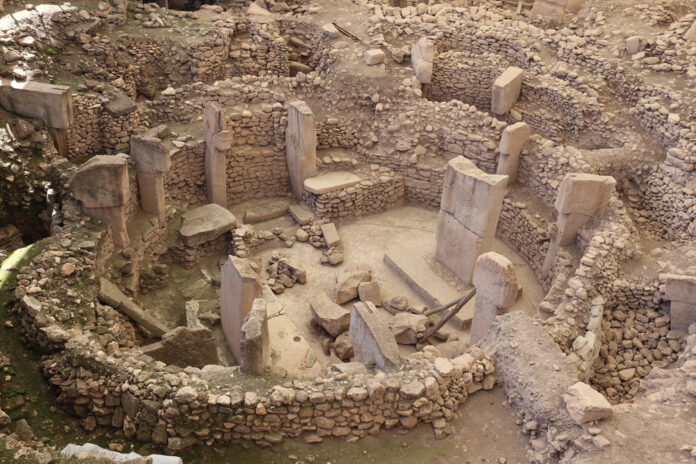Prehistoric peoples may have created the world’s oldest lunisolar calendar thousands of years ago to mark a calamitous comet strike, according to a new study. That conclusion is based on a new interpretation of carvings on stone pillars at the 12,000-year-old site of Göbekli Tepe in Türkiye.
Martin Sweatman, a professor at the University of Edinburgh in Scotland, analyzed a series of V-shaped symbols on a pillar at the site. Sweatman believes each of these shapes represents a single day, with one such pillar counting up to 365.
“We can interpret these V-shaped symbols and little box symbols on the pillar to be counting the days of the year like a calendar,” he says.
A bird-like creature on one of the pillars is also adorned with a V-symbol around its neck and could represent the summer solstice. In total, the pillar recorded 12 lunar months, Sweatman, who published his theory earlier this year in the journal Time & Mind, says. If accurate, it could represent the first and oldest known example of a lunisolar calendar that notes the phases of the moon and the position of the sun in the sky, according to a statement.
What Is Göbekli Tepe?
(Creidt: GC photographer/Shutterstock)
Göbekli Tepe, meaning potbelly hill, is a historical site dating back to 9,600 and 8,200 B.C.E., in an age known as the Pre-pottery era. It contains megalithic temple-like structures and T-shaped pillars constructed by hunter-gatherers who left behind carved depictions of a multitude of wild animals, such as lions, gazelles, vultures, and snakes.
As for why the calendar came to be, Sweatman believes it may be in remembrance of a cluster of comet fragments that struck the earth 13,000 years ago, or around 10,850 B.C.E. Previous research by Sweatman suggested that a carved pillar, known as the vulture stone, is a “date stamp” and depicts some kind of memorial to the comet cluster event. This interpretation is, however, questioned by other researchers.
Read More: Which Ancient City Is Considered the Oldest in the World?
The Younger Dryas Impact Hypothesis
This impact event, known as the Younger Dryas Impact Hypothesis, has proven controversial and continues to divide scientists. The event, according to research, may have triggered a 1000-year-long ice age, wiping out many large animals, including mammoths, and dramatically marking the growth of human civilization. It’s believed the collision may have spurred the development of agriculture and, as Sweatman says, even religion or cult-like practices.
“The main view is that these large enclosures had some kind of cultic purpose,” Sweatman says. “We’re suggesting that perhaps because astronomy seems to be important, they were observing the solstices and the equinoxes. Perhaps there were festivals related to the solstices and equinoxes.”
Read More: The 6 Most Iconic Artifacts From The Ancient World
Was Göbekli Tepe a Religious Site or Ancient Settlement?
(Credit: Mya2019/Shutterstock)
Other researchers have theorized that Göbekli Tepe was home to one of the world’s oldest religious sites and acted as a place of ritual for hunter-gatherers who had yet to settle. Others question this conclusion as it would essentially overturn existing beliefs that the development of religion only came after agricultural practices and domestication of livestock became widespread. Other recent discoveries indicate the site was, in fact, much more than a temple complex and was actually the home to a large settlement.
Interpretations of some archaeological evidence, particularly human skulls, have also led to the belief that the settlement involved a “skull cult,” either as a way to connect with ancestors or to display the heads of enemies killed in battle. Amongst findings of human remains and flint tools, researchers also uncovered a life-size statue of a boar crafted from limestone that showed evidence of painting.
Read More: Is Gunung Padang the Oldest Pyramid in the World?
Prehistoric Knowledge of Astronomy at Göbekli Tepe
Sweatman says that his lunisolar calendar interpretation would indicate prehistoric knowledge of the precession of the equinoxes — a cyclic wobbling of Earth on its axis — thousands of years before the Greek astronomer Hipparchus first noted this in 150 B.C.E.
“It tells us so much about what the people back then were capable of if we’re correct,” Sweatman says. “It tells us that they were good naked eye astronomers, much more advanced in their knowledge of astronomy than generally given credit for.”
Read More: Gobekli Tepe: The World’s First Astronomical Observatory?
Article Sources
Our writers at Discovermagazine.com use peer-reviewed studies and high-quality sources for our articles, and our editors review for scientific accuracy and editorial standards. Review the sources used below for this article:
Sean Mowbray is a freelance writer based in Scotland. He covers the environment, archaeology, and general science topics. His work has also appeared in outlets such as Mongabay, New Scientist, Hakai Magazine, Ancient History Magazine, and others.
Source : Discovermagazine















